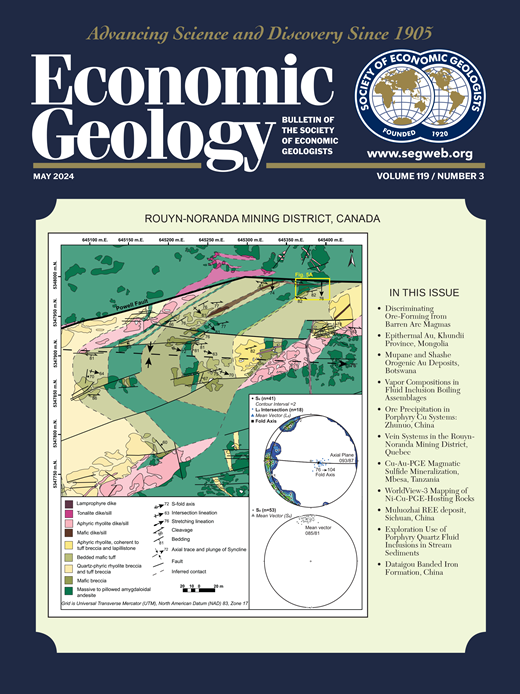Using Machine Learning to Characterize the Genesis of Lithium-Bearing Sedimentary Rocks in the Western United States
IF 4.9
1区 地球科学
Q1 GEOCHEMISTRY & GEOPHYSICS
引用次数: 0
Abstract
The lithium used in batteries is currently sourced exclusively from high-altitude saline brines and pegmatites in orogenic metamorphic belts. In the coming years, lithium-bearing volcano-sedimentary deposits are expected to become an increasingly important source of lithium, with several volcano-sedimentary deposits under varying stages of development throughout the Basin and Range province (United States and Mexico) and Serbia. Foremost among these is the Thacker Pass project hosted in lacustrine moat sediments of the ~16.3 Ma McDermitt caldera, Nevada, United States. Because this type of deposit is critical to obtaining a secure domestic supply of lithium in the United States, we initiated a study on more than 50 basins in 21 states. Through observational field work, detailed sampling, and geochemical analyses on the stratigraphic sequences of interest, we created a database of over 1,500 samples characterizing sedimentary basins in the western United States to ascertain the occurrences and formation of volcano-sedimentary lithium deposits. We use multinomial logistic regression and principal component analysis in addition to basic statistical analysis to create a predictive model for lithium concentration utilizing key features of each basin. Basins containing economic (>1,000 ppm) lithium are predominantly characterized by Miocene-aged, small (<1,500 km2) closed lacustrine systems, with volcanic input, containing fine-grained clay material, often deposited under reducing conditions. The model can be used to predict the concentration of lithium in sedimentary databases without lithium data and can be applied as a modern tool for volcano-sedimentary lithium deposit exploration in basins globally.利用机器学习表征美国西部含锂沉积岩的成因
目前用于电池的锂主要来源于造山变质带的高海拔盐水和伟晶岩。在未来几年,含锂火山沉积矿床预计将成为锂的重要来源,在盆地和山脉省(美国和墨西哥)和塞尔维亚,有几个火山沉积矿床处于不同的开发阶段。其中最重要的是位于美国内华达州~16.3 Ma McDermitt火山口湖护城河沉积物中的Thacker Pass项目。由于这种类型的矿床对美国国内获得安全的锂供应至关重要,我们对21个州的50多个盆地进行了研究。通过实地观测工作、详细取样和对感兴趣的地层序列的地球化学分析,我们创建了一个包含1500多个样品的数据库,这些样品表征了美国西部沉积盆地的特征,以确定火山沉积锂矿床的赋存和形成。除了基本的统计分析外,我们还使用多项逻辑回归和主成分分析,利用每个盆地的关键特征建立了锂浓度的预测模型。含经济锂(1,000 ppm)的盆地主要以中新世为特征,小型(1,500 km2)封闭湖泊体系,火山输入,含有细粒粘土物质,通常在还原条件下沉积。该模型可用于无锂数据的沉积数据库中锂的浓度预测,可作为全球盆地火山-沉积锂矿床勘探的现代工具。
本文章由计算机程序翻译,如有差异,请以英文原文为准。
求助全文
约1分钟内获得全文
求助全文
来源期刊

Economic Geology
地学-地球化学与地球物理
CiteScore
10.00
自引率
6.90%
发文量
120
审稿时长
6 months
期刊介绍:
The journal, now published semi-quarterly, was first published in 1905 by the Economic Geology Publishing Company (PUBCO), a not-for-profit company established for the purpose of publishing a periodical devoted to economic geology. On the founding of SEG in 1920, a cooperative arrangement between PUBCO and SEG made the journal the official organ of the Society, and PUBCO agreed to carry the Society''s name on the front cover under the heading "Bulletin of the Society of Economic Geologists". PUBCO and SEG continued to operate as cooperating but separate entities until 2001, when the Board of Directors of PUBCO and the Council of SEG, by unanimous consent, approved a formal agreement of merger. The former activities of the PUBCO Board of Directors are now carried out by a Publications Board, a new self-governing unit within SEG.
 求助内容:
求助内容: 应助结果提醒方式:
应助结果提醒方式:


